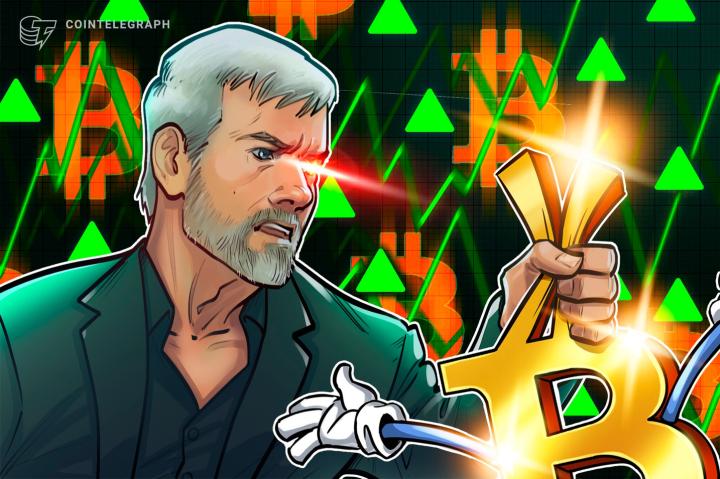- Smart contract platforms are the core infrastructure for decentralized applications and blockchain-based finance. As such, they are central to the vision of public blockchains to provide a new architecture for financial markets and digital commerce.
- Grayscale Research believes that the adoption of smart contract-based applications will accelerate in the next 1-2 years, partly due to U.S. regulatory changes and upcoming legislation.
- Ethereum is the largest smart contract platform based on (i) market capitalization, (ii) the size of its application ecosystem and developer community, and (iii) the value of its on-chain assets. However, it has recently fallen behind some competitors, including Solana, on metrics such as fees and on-chain activity.
- In our view, Ethereum’s differentiating features — including a culture that emphasizes decentralization, security, and neutrality — will help it continue to capture a significant share of users, developers, and transaction fees, even as newer blockchains gain adoption and take market share. As such, Ether should be considered an important component of a diversified cryptocurrency portfolio.
- The outlook for smart contract platform fees is uncertain, in part because we are unsure how much pricing power platforms like Ethereum will be able to maintain in the long term. However, in this report, Grayscale Research shows how Ethereum could potentially grow total fees from an annualized $1.7 billion over the past six months to over $20 billion by executing its scaling strategy and maintaining pricing power.
Along with Linux, Python, and a few other examples, Ethereum can be considered one of the most important open source software projects in history. Although it is less than 10 years old, today, the Ethereum network already contains more than 11,000 nodes, processes 35 million to 40 million transactions per month, secures approximately $46 billion in value, and is supported by more than 2,100 full-time developers. Today, the broader Ethereum ecosystem - composed of interconnected blockchains - processes approximately 400 million transactions per month.
Despite its significant presence in the crypto industry and the launch of spot-based exchange-traded products (ETPs) last year, the Ethereum network’s Ether (ETH) token has lagged significantly behind Bitcoin (BTC) in terms of market capitalization. In fact, the ETH/BTC price ratio has fallen back to mid-2020 levels (as shown in Figure 1). By market capitalization, Ether has added approximately $9 billion to its value since the end of 2022.
Exhibit 1: Ether has underperformed Bitcoin for 2-plus years
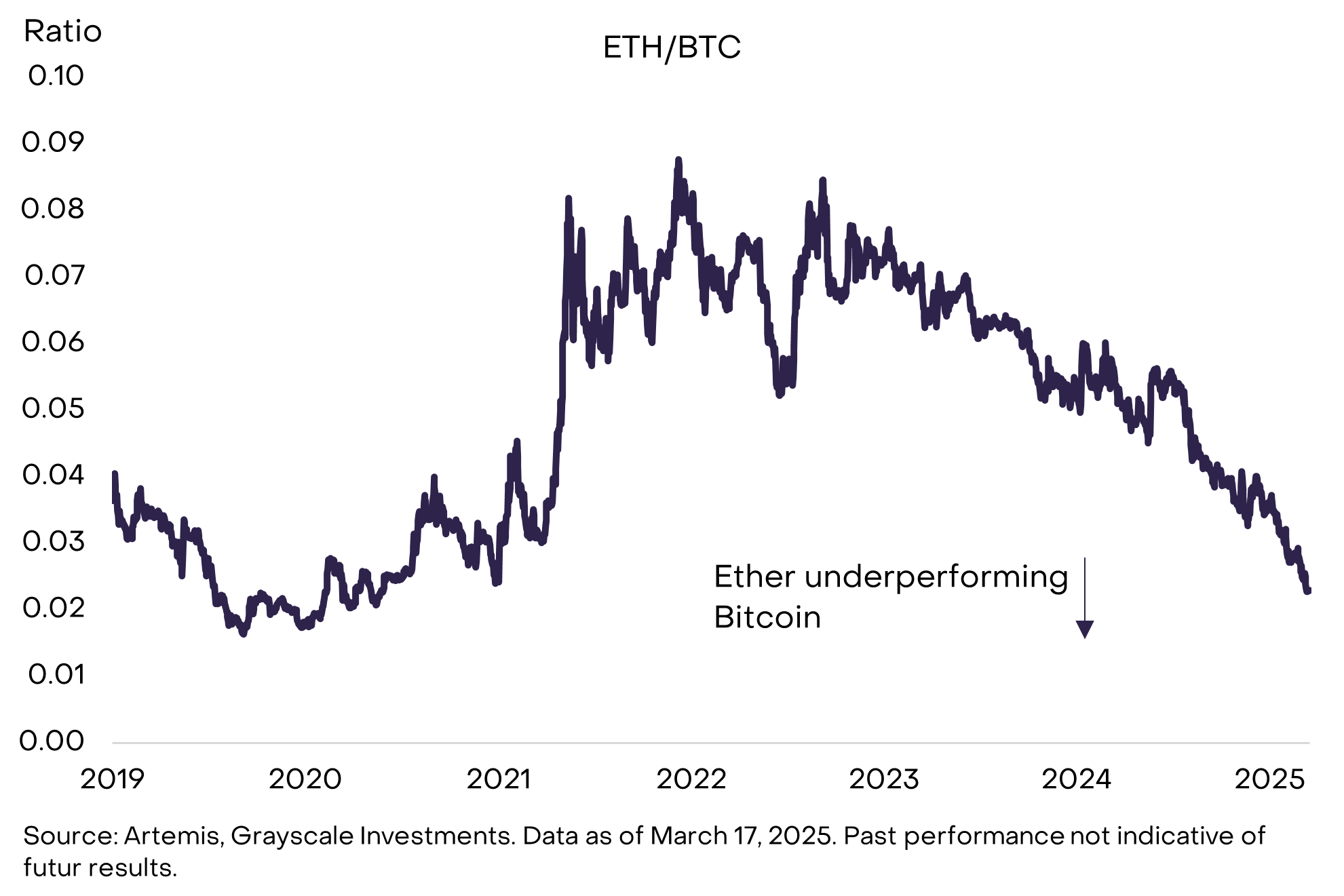
Continued underperformance has led some observers to question the outlook for Ethereum network activity and the value of the Ether token. Despite uncertainty about the outlook for every crypto asset, we believe that Ether should be considered a key component of a diversified crypto portfolio.
Ethereum is not directly comparable to Bitcoin. The Bitcoin network is a monetary system, and the Bitcoin asset is primarily used as a medium of exchange and a store of value. As such, it is an important asset for institutional investors such as Grayscale. Bitcoin's relatively strong price returns reflect investor demand for its properties as a scarce and censorship-resistant digital currency.
Ethereum, in contrast, is an application platform, and Ether provides utility to users of those applications. Ethereum is part of Grayscale’s portfolio, similar to Solana, Stacks, Sui, and many other blockchain networks. Despite the promise of smart contract technology, we have yet to see widespread adoption of smart contract-driven decentralized applications. While there have been many early success stories — including the growth of stablecoin trading — current adoption rates are still very low compared to the vision of smart contract platforms, which aim to move much of traditional finance onto the blockchain.
Grayscale Research believes that smart contract-based applications will accelerate adoption in the next 1-2 years, in part due to changes in U.S. regulatory policy and upcoming legislation. The Trump administration has made adjustments to federal cryptocurrency policy that will help the industry invest and grow in the United States. This legislation builds on the efforts of the previous Congress and aims to provide a comprehensive regulatory framework for the issuance of payment stablecoins. Clearer regulation will help promote investment and adoption of blockchain applications, thereby increasing on-chain activities (such as transactions and fees), and ultimately bringing value growth to the tokens of smart contract platforms.
After its initial lead, Ethereum now faces strong competition from other smart contract platforms, so it needs to execute on its ambitious development plans to succeed. However, Ethereum also has some unique features that we believe will be particularly valuable in financial applications, including large on-chain capital pools and design choices that emphasize decentralization and neutrality. Therefore, we expect Ethereum to account for a significant share of future on-chain activity, which in turn will drive the value of the Ether token.
Everything Is Computer
Ethereum is the first major smart contract platform blockchain. Just like Bitcoin, the Ethereum blockchain can be used to send and receive transactions. However, with the addition of smart contracts, Ethereum is not only able to process transactions, but also run decentralized applications (DApps). These applications can be anything from decentralized lending platforms, identity solutions, and even video games.
Today, Ethereum hosts thousands of applications and is the largest asset by market cap in our smart contract platform crypto industry. Ethereum’s on-chain assets (such as stablecoins and tokenized assets) exceed those of other leading smart contract blockchains, but it lags behind some other blockchains in recent measures of on-chain activity (see Chart 2). Solana, the second largest blockchain by market cap, has higher active addresses, transaction volume, and fees over the past 30 days, but its market cap is only 30% of Ethereum’s.
Exhibit 2: Ethereum is the largest smart contract platform by market cap
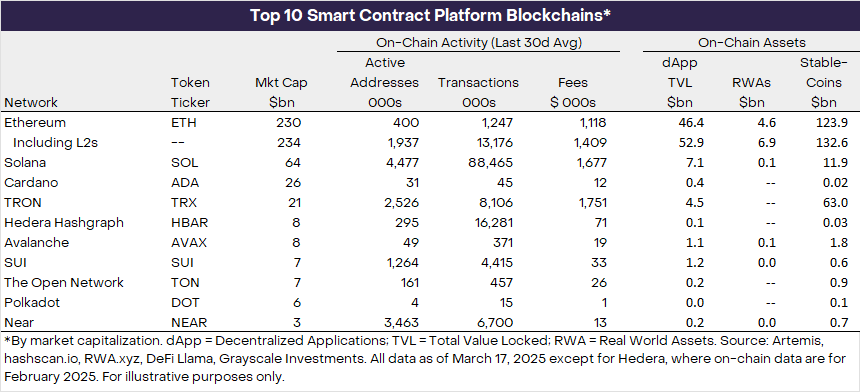
The investment thesis for smart contract platforms is that new applications will bring more users, more transactions, and ultimately more fees to the underlying protocol. We estimate that transaction volume for smart contract platforms has grown from about 20 transactions per second (TPS) five years ago to about 1,200 TPS today, an annualized growth rate of about 130% (see Figure 3). In contrast, the Visa network processed about 7,400 TPS in the 12 months ending September 30, 2024.
Exhibit 3: Smart contract blockchains process ~1,200 transactions per second
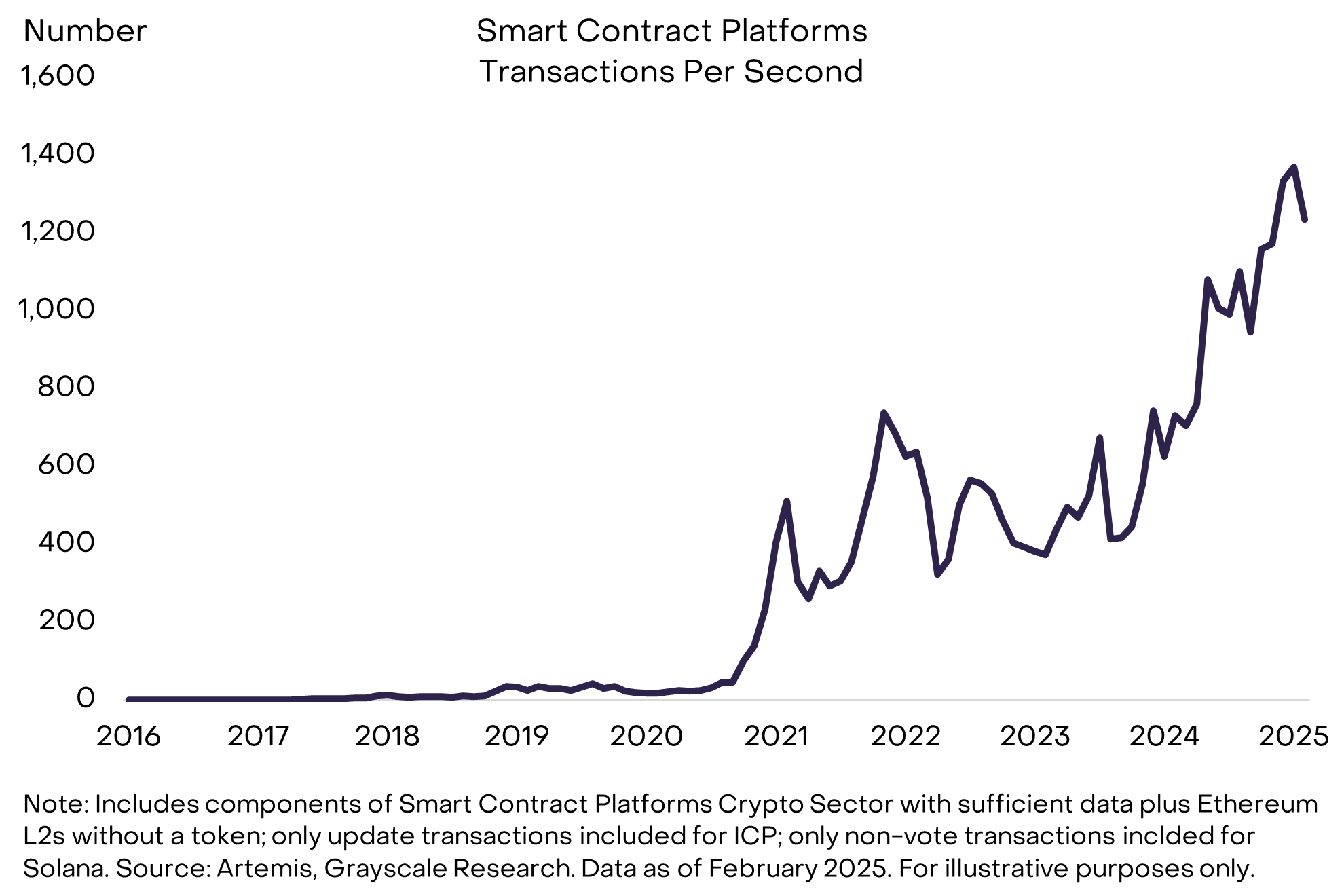
Ethereum’s performance is generally in line with its peers, as measured by the FTSE/Grayscale Smart Contract Platform Crypto Sector Index (Exhibit 4). This market sector currently consists of 70 tokens with a total market capitalization of $428 billion. Since the beginning of 2024, the Smart Contract Platform Index has fallen 22%, while the price of Ethereum has fallen 18%. In contrast, the price of Solana has risen 18% and the price of Bitcoin has risen 90%.
Exhibit 4: Ethereum has performed roughly in line with its market segment
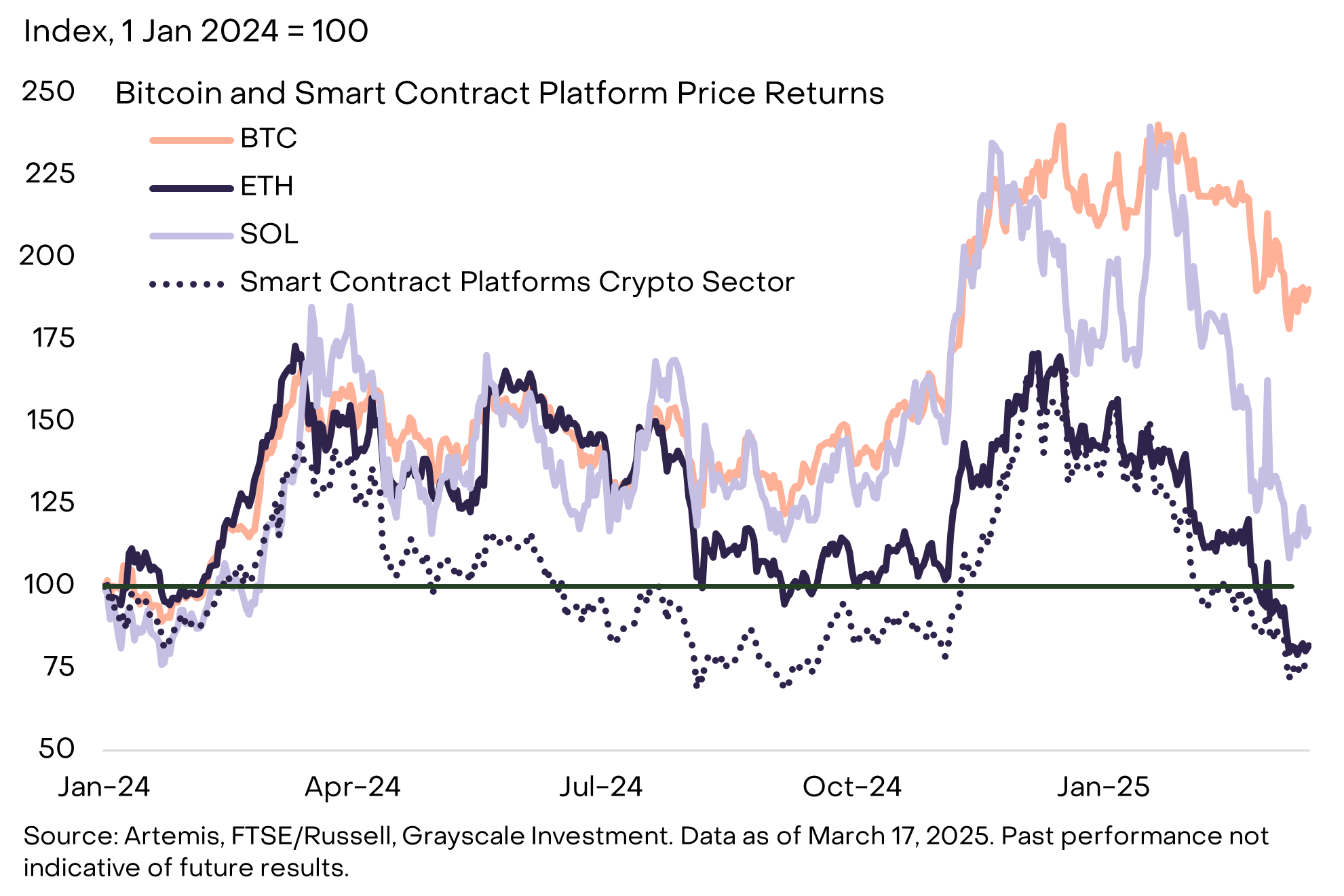
How to make money with Ethereum
Ethereum makes money through transaction fees, which are often referred to as “gas fees” and are payments required to execute transactions or interact with smart contracts. Unlike Solana and many other blockchains, activity in the Ethereum ecosystem occurs both on the Layer 1 (L1) Ethereum mainchain and on a series of Layer 2 (L2) networks. This structure allows Ethereum to scale to more users, as relying solely on L1 cannot expand capacity without sacrificing decentralization. If L1 and L2 can work together, this layered structure will provide users with high-throughput, low-cost L2 transactions while retaining the security and decentralization of L1.
Ethereum's L1 (first layer) and L2 (second layer) networks differ in their gas fee structures, reflecting their different roles in the protocol's scaling strategy. Ethereum's L1 uses a fee model with three different components:
Gas Unit :
Fixed computational costs for certain operations (e.g., ETH transfers require 21,000 Gas).
Base Fee :
The minimum Gas price for blockchain transactions is dynamically adjusted by network demand.
For example, assuming the transaction fee for a 1 ETH transfer (requiring 21,000 gas), when the base fee is 10 gwei and the tip is 2 gwei, the calculation is as follows:
21,000 × (10 + 2) = 252,000 gwei or 0.000252 ETH
Transaction fees create value for token holders through mechanisms similar to dividends and buybacks.
Exhibit 5: Fees are distributed to token holders through staking rewards and burns
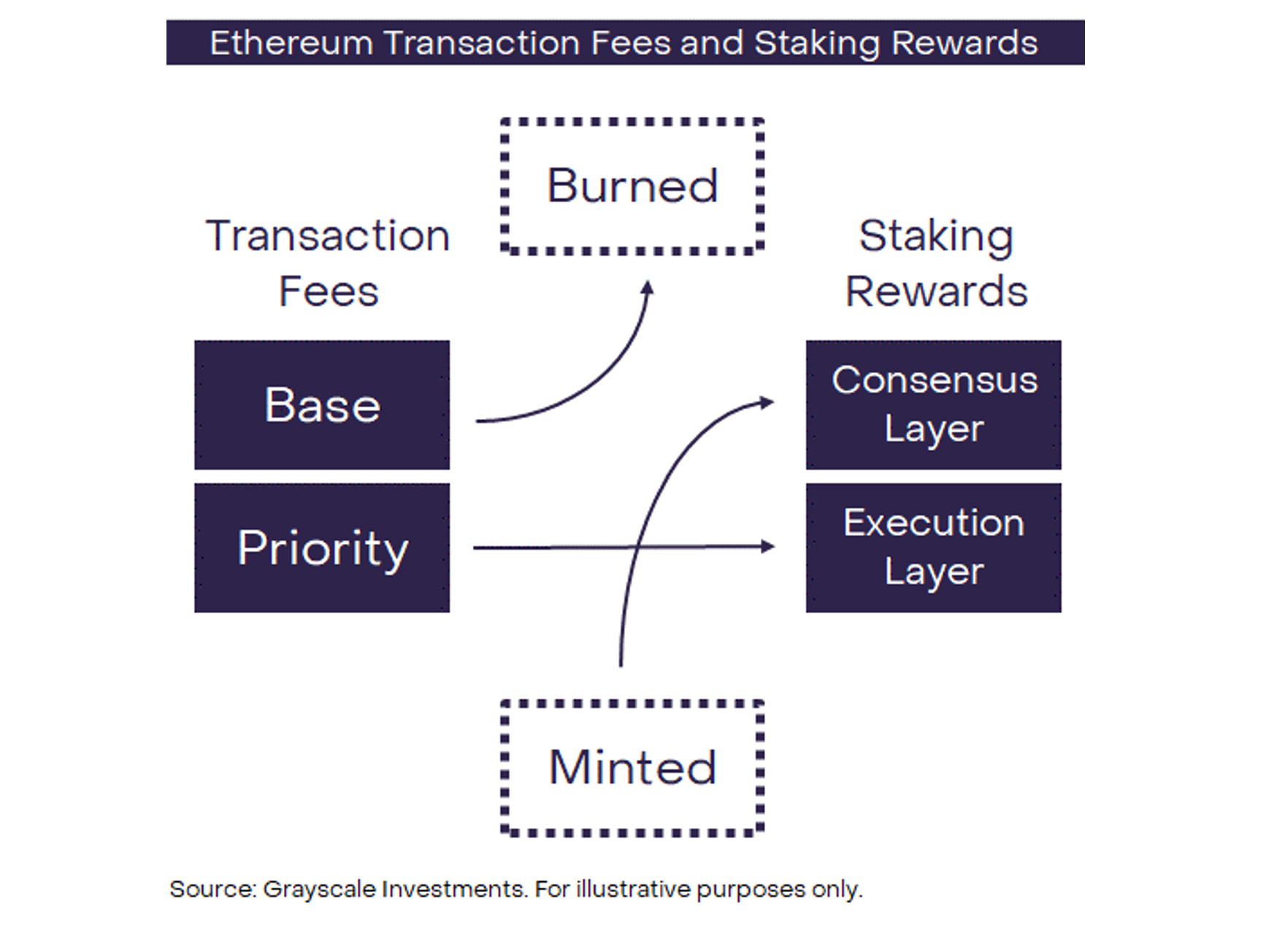 Layer 2 networks like Arbitrum One and Base also charge transaction fees. Because they rely on the Ethereum Layer 1 network for final settlement and security, L2 networks are able to process more transactions with lower transaction fees. However, L2 needs to hand over part of the fees to L1 as payment for settlement and security services. Last year, Ethereum underwent a network upgrade called a "hard fork."
Layer 2 networks like Arbitrum One and Base also charge transaction fees. Because they rely on the Ethereum Layer 1 network for final settlement and security, L2 networks are able to process more transactions with lower transaction fees. However, L2 needs to hand over part of the fees to L1 as payment for settlement and security services. Last year, Ethereum underwent a network upgrade called a "hard fork."
Exhibit 6: Significant growth in activity on Ethereum's L2s
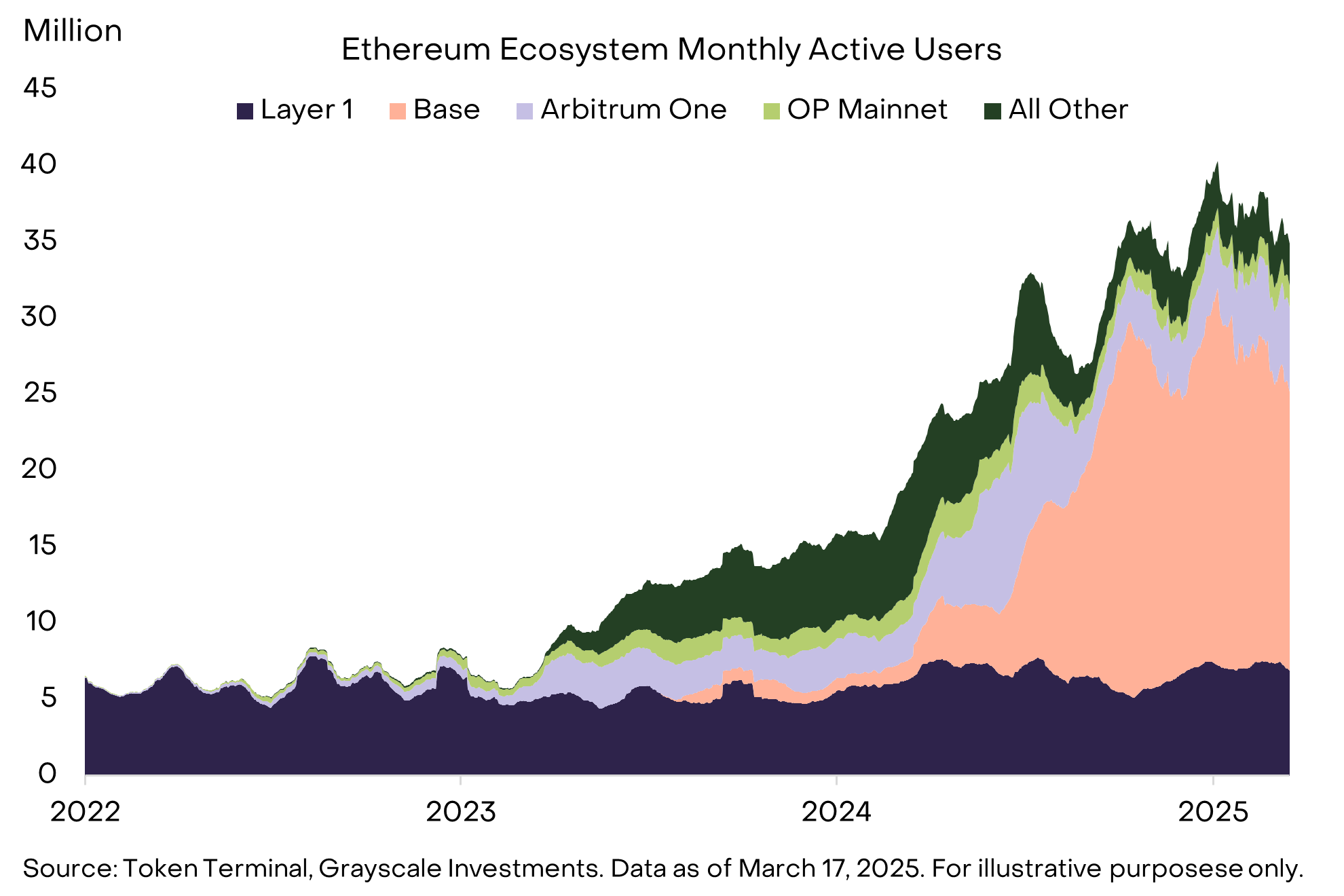
However, the introduction of blob transactions also affects the level and distribution of fees across the network. Most importantly, blob transactions reduce the fees L2 pays to L1 (see Figure 7). This has led some observers to argue that L2 is “parasitic” to Ethereum, as L2’s success in the short term comes at the expense of L1. However, if L2 can benefit from the Ethereum ecosystem, such as its security guarantees and other network effects, then a large L2 ecosystem will ultimately bring greater value to the Ethereum network and ETH in the long run .
Exhibit 7: Ethereum L2s now paying less to the L1
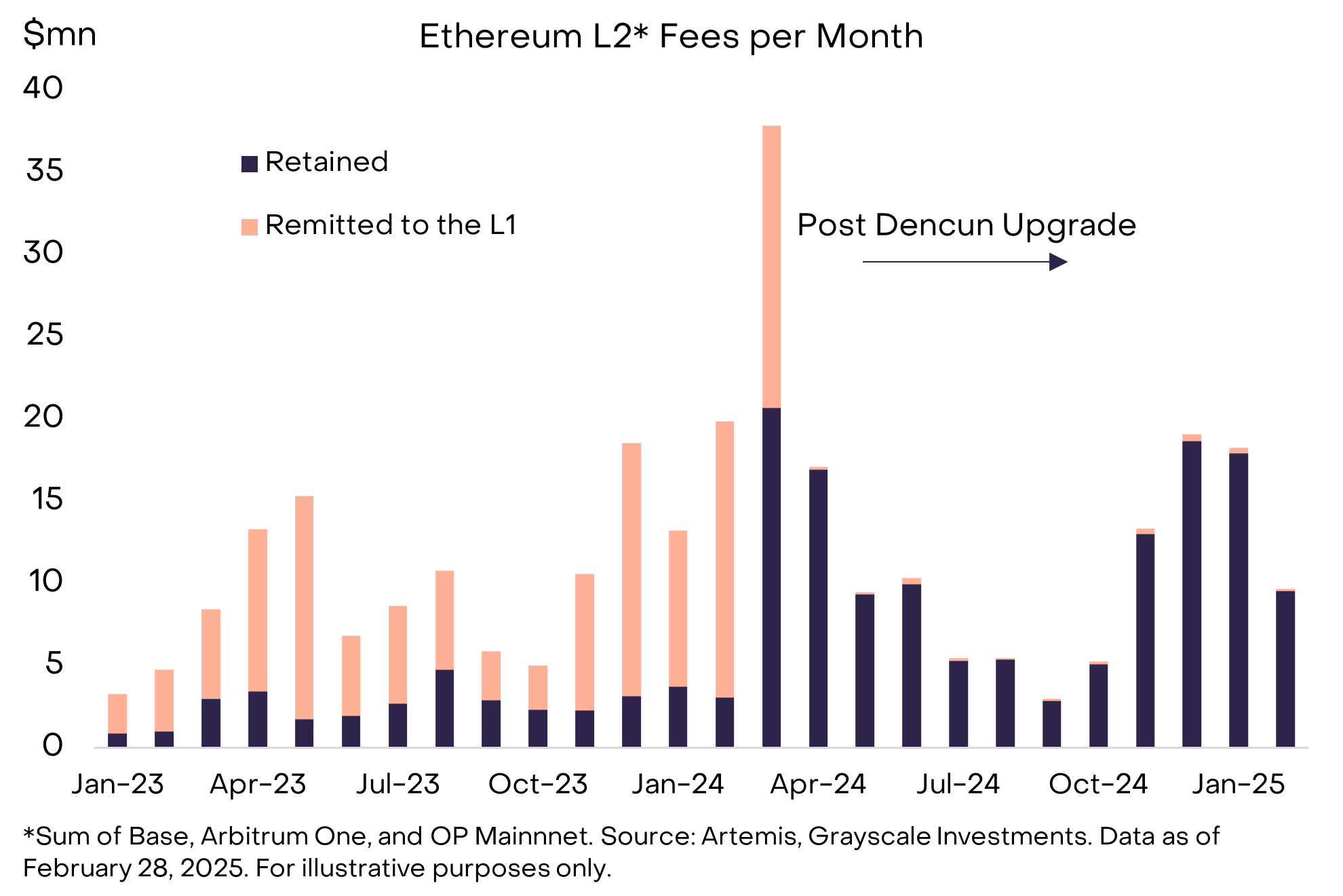 Future upgrades will continue to scale L1 and L2. The Pectra upgrade, scheduled for April 2025, will combine enhancements from Prague (execution layer) and Electra (consensus layer). In particular, in terms of scaling, Ethereum Improvement Proposal-7691 (EIP-7691) optimizes blob storage, targeting 6 blobs per block, twice the capacity of Dencun. Looking ahead, Ethereum's scaling potential may increase significantly, especially through the implementation of a concept called Full Danksharding (see Exhibit 8). The upgrade will expand the number of blobs per block and the size of each blob, significantly increasing the upper limit of TPS. Exhibit 8 shows the impact that Pectra and Full Danksharding may have on the transaction capacity of Ethereum L2.
Future upgrades will continue to scale L1 and L2. The Pectra upgrade, scheduled for April 2025, will combine enhancements from Prague (execution layer) and Electra (consensus layer). In particular, in terms of scaling, Ethereum Improvement Proposal-7691 (EIP-7691) optimizes blob storage, targeting 6 blobs per block, twice the capacity of Dencun. Looking ahead, Ethereum's scaling potential may increase significantly, especially through the implementation of a concept called Full Danksharding (see Exhibit 8). The upgrade will expand the number of blobs per block and the size of each blob, significantly increasing the upper limit of TPS. Exhibit 8 shows the impact that Pectra and Full Danksharding may have on the transaction capacity of Ethereum L2.
Exhibit 8: Future Ethereum upgrades will greatly increase L2 capacity
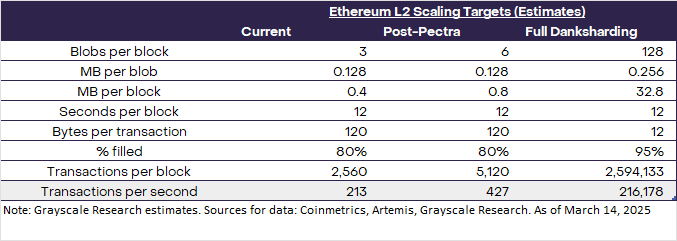 The Outlook for Ethereum Fees
The Outlook for Ethereum Fees
The outlook for Ethereum fees is highly uncertain, in part because the technology is still in its early stages and it is unclear how long platforms like Ethereum can maintain pricing power. Smart contract platforms compete with each other and with centralized systems. To maintain pricing power in the long term, these platforms need to offer differentiated features to prevent users from switching to cheaper (centralized or decentralized) alternatives. Although the Ethereum blockchain is slower and has higher fees than many of its competitors, Grayscale Research believes that its unique advantages — including the high value of on-chain assets and its emphasis on decentralization and security — will help drive adoption and network effects, ultimately providing Ethereum with some pricing power .
Exhibit 9 provides an example of how Ethereum can potentially increase transaction fees by increasing capacity and maintaining pricing power. We assume an average transaction fee of $5 on L1, compared to the average transaction fee of $6.30 since 2019.
In the long run, L1 will be used primarily for high-value transactions and transactions that require high security assumptions. For L2, we assume an average transaction fee of $0.05, which is similar to recent experience. We further assume that Ethereum L1 has a processing capacity of 100 transactions per second (TPS), while Ethereum L2 has a total processing capacity of 25,000 transactions per second. These hypothetical TPS projections are under Ethereum's scaling roadmap and assume the overall growth in demand for smart contract applications, which is expected to be achieved in the next 3-5 years .
Under these assumptions, Ethereum's Layer 1 fees would grow to over $20 billion, significantly higher than the annualized fees of approximately $1.7 billion over the past six months (see Figure 9). While the fee outlook is highly uncertain, if Ethereum executes on its scaling strategy and maintains some pricing power, it should technically be able to significantly increase fee revenue. To track progress, investors should consider monitoring the basic variables in this simplified model - namely, the TPS (transactions per second) of Layer 1 and Layer 2 and the average execution fees of Layer 1 and Layer 2.
Exhibit 9: Ethereum fee revenue can grow with scaling and pricing power
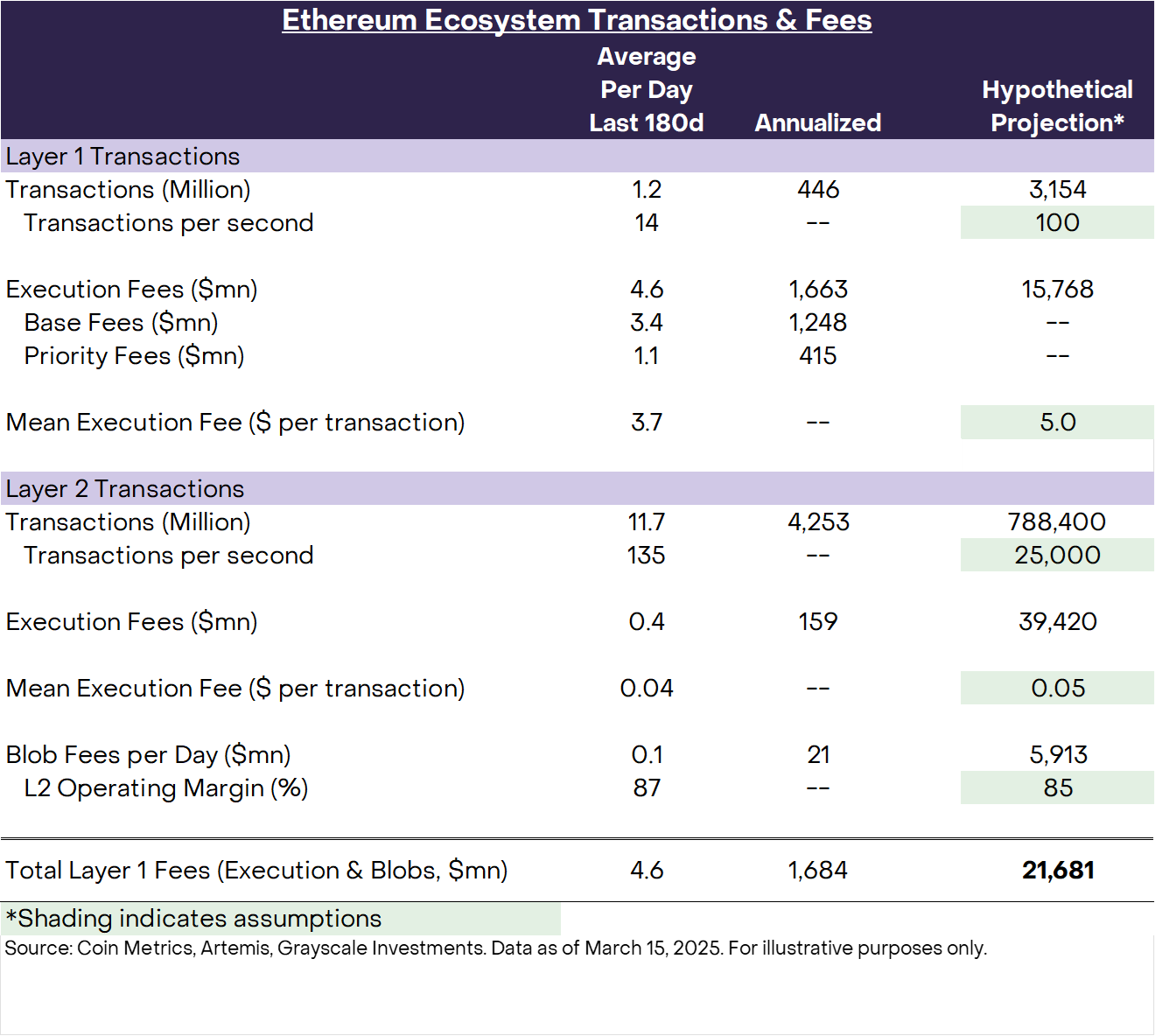
Growing the Pie
In the last cryptocurrency bull run, Bitcoin and Ethereum initially rose in tandem. Then in 2021, Ethereum's price rose faster, ultimately delivering returns roughly twice as high as Bitcoin's from early 2019 to the market peak in November 2021 (see Chart 10). Some cryptocurrency investors may have expected a similar pattern to emerge in the current cycle—with Ethereum significantly outperforming Bitcoin as the cycle matures—but their recent weakness may have disappointed them.
Exhibit 10: Last crypto cycle Ether eventually outperformed Bitcoin
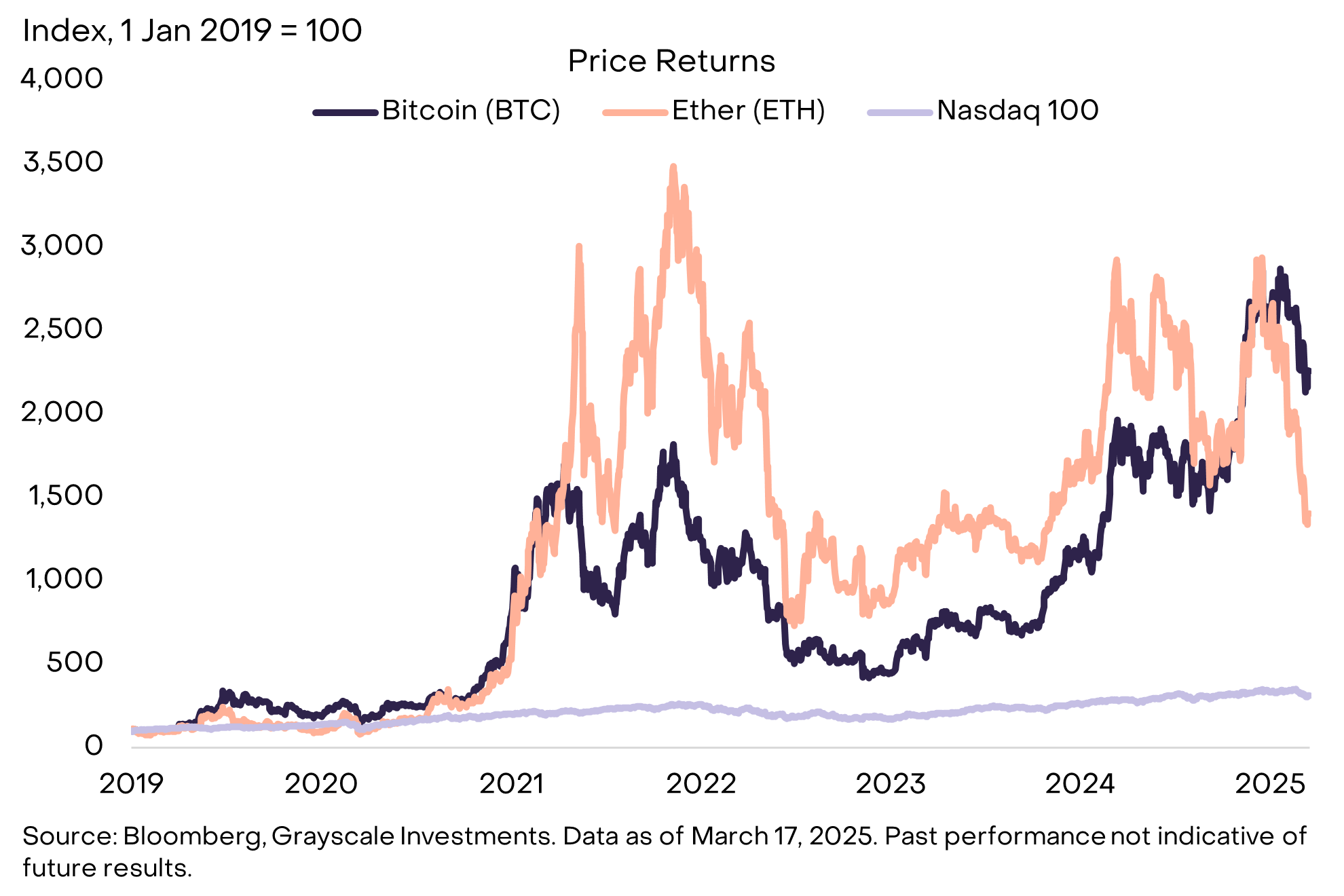 Grayscale Research believes that Ethereum's underperformance is a healthy sign that the crypto market is focusing on fundamentals. In our analytical framework, the market primarily differentiates smart contract platforms by transaction fees.
Grayscale Research believes that Ethereum's underperformance is a healthy sign that the crypto market is focusing on fundamentals. In our analytical framework, the market primarily differentiates smart contract platforms by transaction fees.
In the smart contract platform cryptocurrency space, Ethereum and Solana have relatively high transaction fees and market capitalization (see Figure 11). Since the end of 2023, Solana has gained more fee income and market share in the smart contract platform cryptocurrency space, while Ethereum has lost some fee income and market capitalization. In other words, the market has appropriately repriced the relative value of Ethereum and Solana based on the change in fundamentals. In the simple framework presented in Figure 11, Solana has moved to the upper right and currently looks roughly fairly valued (it has "grown into its valuation"). Conversely, Ethereum has moved to the lower left and is currently likely overvalued given the premium it has on its fee income.
Exhibit 11: Ethereum underperformed Solana due to weaker fee growth
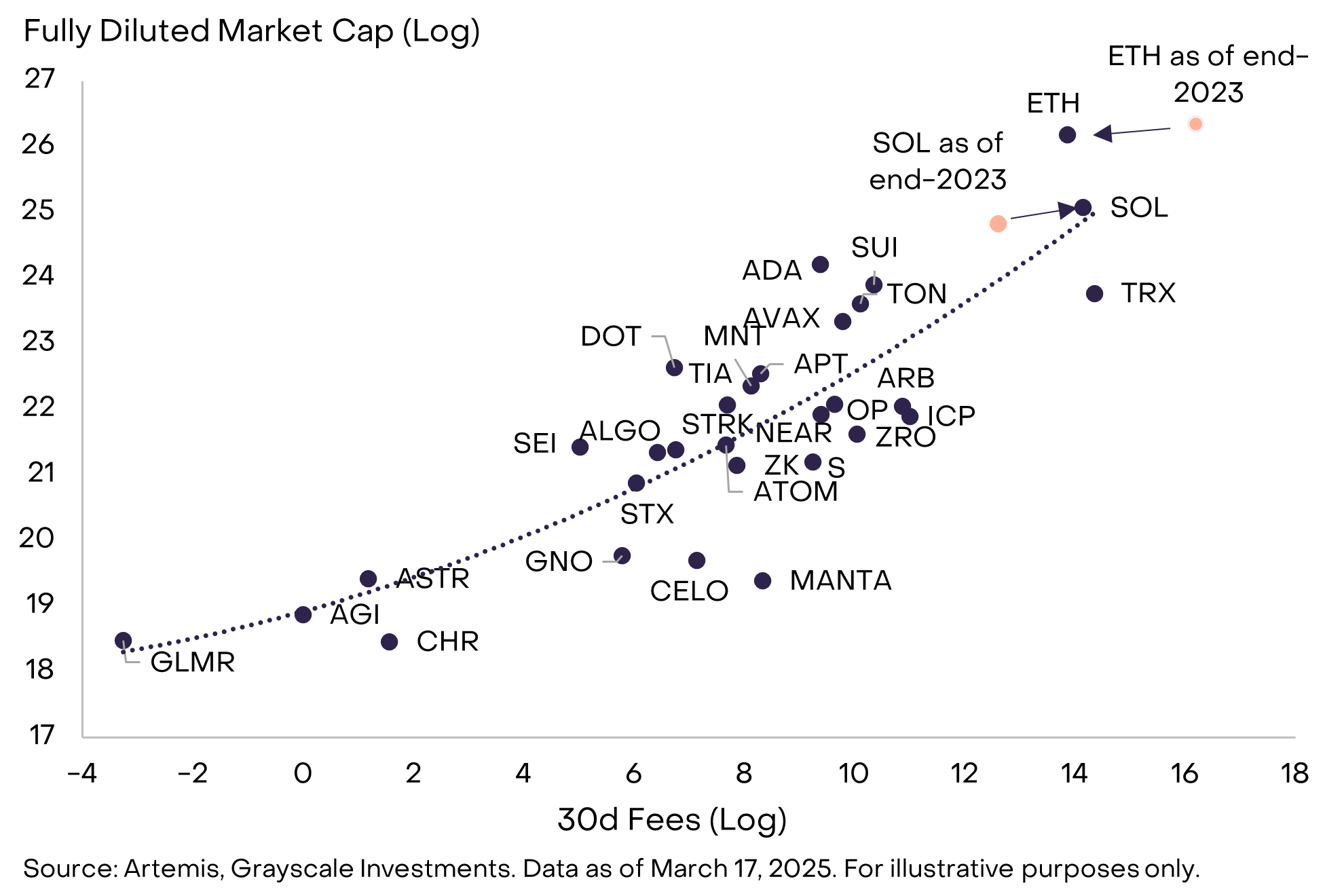 These small differences in competitive position are important, but not as significant as the potential growth of the category as a whole. Adoption of all smart contract platforms is still in its early stages. For example, Ethereum currently has only about 7 million monthly active users, while Facebook parent Meta Platforms reported 3.35 billion "daily active users" of its applications in December 2024. As adoption increases, smart contract platforms are expected to benefit from compounding network effects, with increased participation driving not only higher transaction volumes and fee revenues, but also accelerating developer activity, liquidity depth, and interoperability across the ecosystem. This reinforcing cycle of adoption and utility has the potential to amplify value capture for the entire category.
These small differences in competitive position are important, but not as significant as the potential growth of the category as a whole. Adoption of all smart contract platforms is still in its early stages. For example, Ethereum currently has only about 7 million monthly active users, while Facebook parent Meta Platforms reported 3.35 billion "daily active users" of its applications in December 2024. As adoption increases, smart contract platforms are expected to benefit from compounding network effects, with increased participation driving not only higher transaction volumes and fee revenues, but also accelerating developer activity, liquidity depth, and interoperability across the ecosystem. This reinforcing cycle of adoption and utility has the potential to amplify value capture for the entire category.
The winning networks will likely be those that capture the most transaction fees over a long period of time and have favorable supply and demand structures for their native tokens (e.g., due to supply growth constraints and structural demand as a collateral asset or medium of payment). Solana, Sui, and a number of other smart contract platforms will differentiate themselves from their competitors through high throughput, low transaction costs, and generally attractive user experiences. Ethereum is unique because it has a large and diverse ecosystem of applications and developers, a large amount of on-chain capital, and a culture that prioritizes decentralization, security, and neutrality. We expect these characteristics to continue to attract a large number of users to the Ethereum ecosystem and that Ethereum will account for a significant share of economic activity on smart contract platform blockchains in the future.






